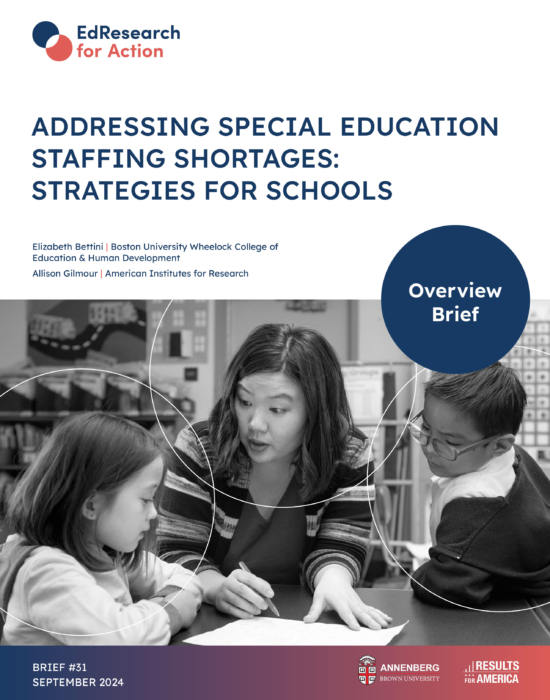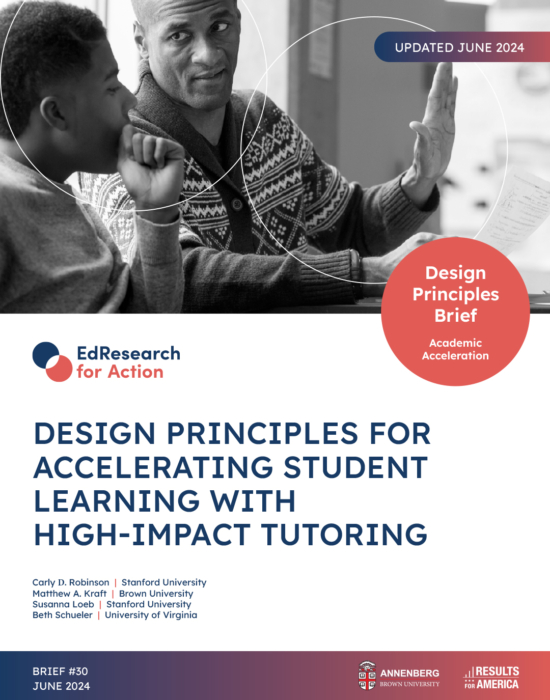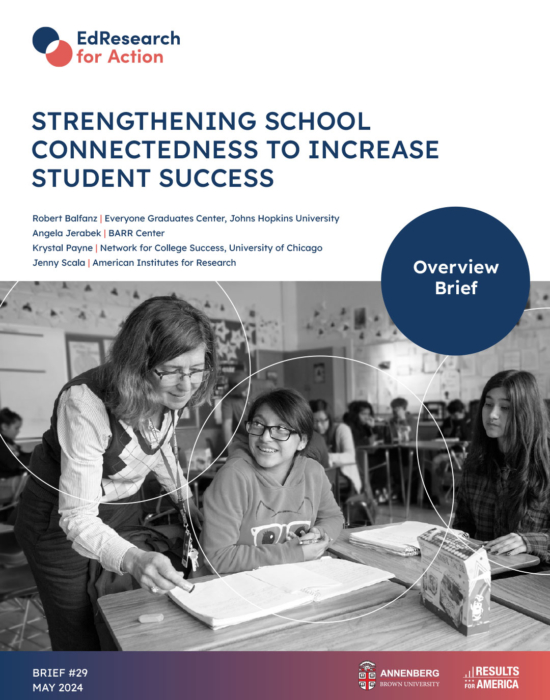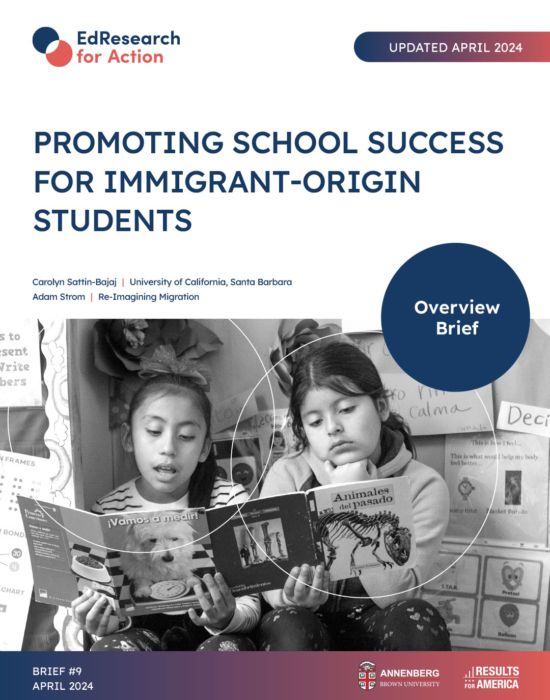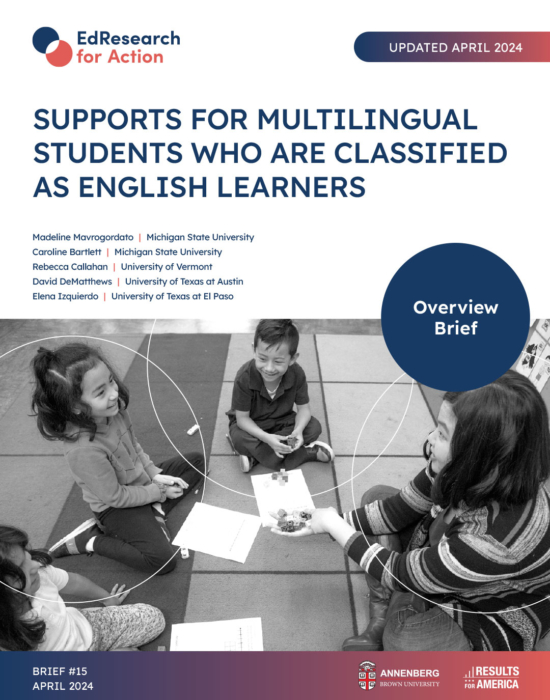SUPPORTS FOR STUDENTS IN IMMIGRANT FAMILIES
The EdResearch for Action Overview Series summarizes the research on key topics to provide K-12 education decision makers and advocates with an evidence base to ground discussions about how to best serve students. Authors – leading experts from across the field of education research – are charged with highlighting key findings from research that provide concrete, strategic insight on persistent challenges sourced from district and state leaders.
Carolyn Sattin-Bajaj | University of California, Santa Barbara
Veronica Boix Mansilla | Harvard University
Adam Strom | Re-Imagining Migration
August 2020 | Brief No. 9
Central Question
What research-backed practices can school districts, schools and classroom teachers use to support immigrant-origin students’ educational success and build inclusive environments in learning contexts transformed by COVID-19?
Key Insights
Breaking Down the Issue
- Immigrant-origin children are the fastest growing segment of the school-age population in the U.S.
- Immigrant communities have been disproportionately affected by COVID-19 in terms of loss of employment, representation among frontline and essential workers, and rates of illness.
- Immigrant-origin students tend to have lower access to at-home resources that might support their learning during the pandemic.
Strategies to Consider
- Culturally-relevant communications with students and families in multiple languages and formats may increase family and caregiver involvement, improve home-school connections, and improve student engagement.
- Immigrant-origin students who receive extracurricular programmatic supports to complete at-home learning activities and assignments show greater academic progress.
- Schools that provide information and guidance about immigrants’ legal and educational rights and available services can be instrumental in supporting immigrant students’ school engagement and success.
- Schools that embrace and incorporate the diversity of languages, identities, cultures, and family practices represented in their communities benefit from increased engagement and cross-cultural learning.
- For immigrant-origin students to thrive, districts must know about and take seriously anti-immigrant hate and address student trauma
Strategies to Avoid
- New modes of schooling create new concerns and exacerbate existing challenges around privacy and immigration status.
- Failure to acknowledge and attend to the basic and socioemotional needs of children in immigrant families who may be experiencing additional stressors related to immigration or undocumented status misses a critical aspect of ensuring students’ wellbeing and readiness to learn.
Breaking Down the Issue
Note: There is considerable overlap between the immigrant-origin population and the English learner (EL) population. This brief focuses on the former. An additional brief in the series will look at research-based practices for English learners.
Immigrant-origin children are the fastest growing segment of the school-age population in the U.S.
- Roughly 20 million children (25% of the country’s school-age population) have at least one foreign- born parent; immigrants comprised over 14% of the U.S. population in 2017.
- Among K-12 students of immigrant-origin, around 10% are first generation immigrants and 90% are U.S.-born children of immigrants (second generation).
- About half of this population is Latino/a and 10.1% are classified as English learners. Since 2008, immigrants from Asia (mostly China and India) have been the largest group of new arrivals.
- Four million children, or 8% of all children enrolled in public and private K–12 schools in the United States, are living with at least one undocumented parent.
- Approximately 675,000 children in U.S. schools are themselves undocumented.
Immigrant communities have been disproportionately affected by COVID-19 in terms of loss of employment, representation among frontline and essential workers, and rates of illness.
- Unemployment rates rose faster among immigrants than U.S.-born workers between January and April 2020, particularly among immigrant women, largely due to the sectors in which their work is concentrated, including leisure and hospitality, personal services, and retail.
- Immigrants are disproportionately represented among frontline healthcare and essential workers as doctors, nurses, pharmacists and home health aides.
- COVID-19 death rates are higher among Black Americans and Latinos/as than White Americans in every age group.
Immigrant-origin students tend to have lower access to at-home resources that might support their learning during the pandemic.
- Immigrant-origin children are more likely to live in poverty.
- As of 2017, 47% of immigrant-origin children were living in poverty compared to 17% of non-immigrant-origin children.
- Low-income students are predicted to have significantly larger learning losses due to COVID-19 than their higher income peers.
- Households that are lower-income, Latino/a, and headed by adults with less than a high school diploma are less likely to have broadband internet and more likely to rely on smartphones for internet, which may be less conducive to virtual schooling.
- Children in immigrant families may have additional work, child care, or other responsibilities that limit their time and capacity to complete at-home assignments.
- Children in undocumented families may be ineligible for some of the federally funded COVID-19-related resources.
- Undocumented immigrants are ineligible for supports such as federal unemployment insurance benefits, making them particularly vulnerable to the economic fallout from the pandemic.
- Even when eligibility is not a barrier, undocumented immigrants may be reluctant to apply for public benefits because of concerns about confidentiality of the personal information they provide.
- Children living in undocumented or mixed-status households may have greater concerns about online privacy and security when learning in virtual settings, leading to decreased participation.
Strategies to Consider
Culturally-relevant communications with students and families in multiple languages and formats may increase family and caregiver involvement, improve home-school connections and improve student engagement.
- School districts are legally mandated to provide education-related information in languages that every family understands.
- Many larger school districts already have interpretation hotlines in place; school leaders and teachers can use these hotlines to set up conversations with families.
- Smaller districts can partner with local community organizations to expand their translation and interpretation capacity and have resources translated more quickly. For example, the Sioux Falls School District established a partnership with SD Voices for Peace, which produced translations of relevant COVID-19-related materials in multiple languages.
- Translation apps can be used to fill in gaps in district translation and interpretation services and in emergency situations but are not recommended as the primary or sole source for translation. Talking Points is an app that translates messages between districts/teachers and families in many different languages. Users are not required to download an app and families receive messages as a text message; individual and mass texts can be sent while protecting privacy.
- Some districts have built direct programs that foster stronger ties with immigrant families and help immigrant parents become more effective advocates for their children.
- A study of a Mexican immigrant parent empowerment effort in a California school district found that creating opportunities in which immigrant families created meeting agendas and helped determine resource allocations allowed parents to feel a part of their children’s schools and schooling and take more active roles. Activities such as workshops on topics chosen by parents helped immigrant parents learn how to help their children to succeed educationally. Evidence of attempts at power sharing on the part of the district and investment in special programs for Spanish-speaking students and families validated families’ social and cultural experiences and increased home-school cooperation.
- A separate experimental study evaluating the effects of daily phone calls and text message communications from teachers to parents of children participating in a mandatory summer school program found that more frequent communication immediately increased students’ homework completion rates (by 40%), class participation (by 15%) and on-task behavior (by 25%). Over 30% of the treatment group were students classified as “limited English proficient” indicating a sizable proportion of immigrant-origin students/families in the sample.
- The Immigrant Parent Leadership Initiative at Annandale High School in Virginia provides an example of a program where support, information, and resources aimed specifically at immigrant parents provided a direct avenue for family involvement.
- Districts that do not have capacity or expertise in house to develop programs like these can provide similar supports by partnering with local culturally-specific community-based organizations (including faith-based, immigrant-serving, health, and advocacy organizations) that have already established relational trust with immigrant families.
Immigrant-origin students who receive extracurricular programmatic supports to complete at-home learning activities and assignments show greater academic progress.
- Both formal programs and after-school activities have been shown to improve academic performance for immigrant youth.
- One study of high school-age newcomer immigrant students found that attending homework help sessions at school was a key contributor to homework completion.
- School districts can partner with community-based organizations, public libraries and municipal offices in their cities and towns that offer homework help and other educational supports and promote their services. These include live, online tutoring and homework help with trained tutors who can provide support in multiple languages. The public library system in Glendale, California, for example, offers live, online homework and writing assistance, tutoring, practice tests, flashcards, and college counseling. Some also offer support for adults including preparation for citizenship tests, Microsoft Office, GED exam preparation, and résumé writing.
- Students in immigrant families are more likely to benefit from assignments that do not exclusively require home computers and broadband internet connections, do not anticipate high levels of parental assistance, are at the appropriate level of English proficiency and draw on students’ own funds of knowledge.
- Homework should provide English learners with an opportunity to develop language skills and reinforce content without demanding an unrealistic level of academic English proficiency.
- Assignments that allow students to build on prior knowledge and to draw on cultural and linguistic resources and learning styles (or funds of knowledge) may better engage linguistic and ethnic minority students and produce more successful results.
Schools that provide information and guidance about immigrants’ legal and educational rights and available services can be instrumental in supporting immigrant students’ school engagement and success.
- School districts can affirmatively demonstrate their commitment to inclusion and support of undocumented students and families through widespread messages, legal services and information, and removal of barriers to access and enrollment in schools.
- The Boston Public School system created the website, We Dream Together, to publicly show support and bring together resources specifically targeted toward undocumented students. The Minneapolis Board of Education released a public resolution affirming all students’ rights to be in school.
- Teachers, school counselors, and school support staff that encourage undocumented students, foster their educational aspirations, and present themselves as willing sources of guidance have been found to positively influence students’ academic and life trajectories.
- Districts can provide basic information about immigrants’ rights and offer staff trainings so they are prepared to answer questions and allay students’ fears about security related to their schooling or their families’ safety.
- Disseminating brief readings like Teaching Tolerance’s Guide for Educators or distributing Know Your Rights materials to educators to share with families can be valuable ways to equip educators and support families.
Schools that embrace and incorporate the diversity of languages, identities, cultures, and family practices represented in their communities benefit from increased engagement and cross-cultural learning.
- Opportunities for culturally relevant learning opportunities are essential for sustained engagement and are associated with higher achievement.
- School rituals, daily routines, and every day “schooltalk” can be infused with the value of diversity, including in remote learning situations.
- Messages of inclusion can be displayed in the hallways, public spaces, presentations, school communications, and physical and virtual classrooms.
- Teaching about immigrant-origin students’ histories and cultures, including their families’ stories of immigration across subjects (e.g., art, geography, history, literature, math, and science) offers an avenue to build connections and practice culturally responsive pedagogies.
- Asking students to engage with and reflect on the challenging civic issues of the day that are connected to migration is a compelling way to address real events while building bridges across communities.
- Trusting relationships between educators and immigrant-origin students and safe, supportive school environments can significantly improve their school engagement and outcomes.
- Educators can take advantage of informal opportunities for connecting between classes; teaching virtually, this might mean texting or scheduling quick one-on-one chats. This might require rethinking district regulations about the use of technology to connect with students.
- Inviting students to talk about their stories of movement and migration can help build connection, reduce prejudice, empower immigrant-origin students, and enhance empathy among their peers. Re-Imagining Migration’s Moving Stories resources provide a model storytelling unit for virtual classrooms.
For immigrant-origin students to thrive, districts must know about and take seriously anti- immigrant hate and address student trauma.
- School personnel must be prepared and empowered to intervene to support students who are targeted by discriminatory language and behavior, including how to address online bullying that happens outside of school.
- Sixty-eight percent of school principals report that federal immigration enforcement policies and the political rhetoric around immigration have harmed student well-being and learning and have undermined the work of their schools in general.
- Teachers can create a contract with students to establish norms for classroom discussions and communications and to set clear expectations.
- Intervention online will require contacting students and developing an understanding of their digital habits and lives. (Common Sense Media has a wealth of resources in this area.)
- Experts in youth trauma recommend that child-serving agencies incorporate trauma-informed approaches into their practices to improve the quality of care for young people, including screening for trauma exposure, using evidence-based practices and providing resources about trauma and appropriate care to providers, trauma survivors and families.
- Applying trauma-informed approaches to immigrant-origin children is especially crucial given possible trauma they might have experienced prior to immigrating to the United States as well as new trauma experienced while living in this country. New trauma may result from immigration enforcement policies and COVID-related hate rhetoric, which has been particularly targeted toward members of the Asian-American and Pacific- Islander community.
Strategies to Avoid
New modes of schooling create new concerns and exacerbate existing challenges around privacy and immigration status.
- Districts that do not ask the right questions about student online privacy are likely to weaken their ability to serve immigrant-origin students.
- Districts should ensure students have privacy protection online and should make clear how they are protecting students’ privacy when they are in virtual settings.
- Online privacy might be particularly important to immigrant families who have increased concerns about identification. Districts can explicitly address privacy concerns with clear communications about policies and practices that are translated in multiple languages and available in different formats (e.g., online, printed).
- Undocumented immigrant families tend to avoid interacting with public institutions that may put them at risk of identification or apprehension. Limiting or eliminating bureaucratic hurdles related to school enrollment or accessing materials (e.g., textbooks, district-furnished laptops, iPads, Chromebooks or other devices), may increase take-up and participation among children in undocumented families. This means waiving requirements to show government-issued IDs or submitting forms in-person, for example.
- Children in low-income families are more likely to face technology barriers that impede consistent participation in virtual learning.
- Fear of releasing personal information may further inhibit children with undocumented family members from engaging in online educational activities.
- Confirming families’ correct contact information and preferred forms of communication (e.g., phone call, text, email) is an important first step that may increase receipt of communications from district or classroom teachers and improve two-way communication.
Failure to acknowledge and attend to the basic and socioemotional needs of children in immigrant families who may be experiencing additional stressors related to immigration or undocumented status misses a critical aspect of ensuring students’ wellbeing and readiness to learn.
- Undocumented families are ineligible for many government services and COVID-19-related benefits resulting in increased financial hardship, as well as food and job insecurity.
- Deportation remains an ongoing concern for undocumented immigrants and their families. For students, this means even those who are U.S. citizens may struggle with fear about the dangers of deportation for undocumented parents or other relatives.
- Asian-origin immigrant children have faced heightened discrimination in schools and society since COVID-19 emerged.
- Consequently, educators should consider using trauma-informed educational practices to effectively support and teach immigrant-origin (and all) students experiencing trauma.
- Deportation remains an ongoing concern for undocumented immigrants and their families. For students, this means even those who are U.S. citizens may struggle with fear about the dangers of deportation for undocumented parents or other relatives.





Funding for this research was provided by the Bill & Melinda Gates Foundation. The findings and conclusions contained within are those of the authors and do not necessarily reflect positions or policies of the foundation.

